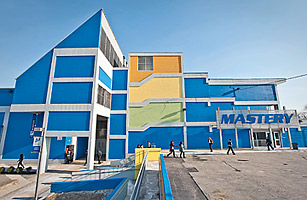
“Ba-Boom!” Leroy Hayes describes sitting in his seventh-grade English class at Philadelphia’s Shoemaker Middle School when he heard the explosion. It was startling but not necessarily surprising, he says. Crazy stuff happened all the time at Shoemaker. Once, he recalls, a student urinated into a soda bottle during class and threw it in a math instructor’s face. Crazy stuff. After hearing the big explosion, Hayes and his friends rushed out of the room and discovered that someone had set off fireworks in the corridor. “The school was in chaos,” the 11th-grader remembers of the 2005 incident. “People were laughing and screaming and saying, ‘Do another one, do another!’ It was out of hand. But,” he adds, in a succinct assessment of the crisis in U.S. public education today, “it’s not like we were learning anything in class anyway.” In 2006, Shoemaker was considered one of Philadelphia’s most troubled schools. Fewer than a third of its eighth-graders exhibited proficiency on the state math exam. Fewer than half were proficient in reading. Violence was common, and students had full run of the hallways. Most of the bulletin boards had been torched, and the principal’s office had metal bars on the windows. One teacher says even the UPS guy was hesitant to go inside. The Obama Administration has a plan: take the 5,000 worst schools in the U.S. and give them more than $4 billion over three years to get a lot better — fast. It’s the emphasis on speed that makes this endeavor something new. The government has thrown big money at education for decades, with very little to show for it. Even under NCLB, most of the failing schools that were forced to make changes did the bare minimum required by federal mandates. See the 10 best college presidents.
See pictures of eighth-graders being recruited for college basketball.